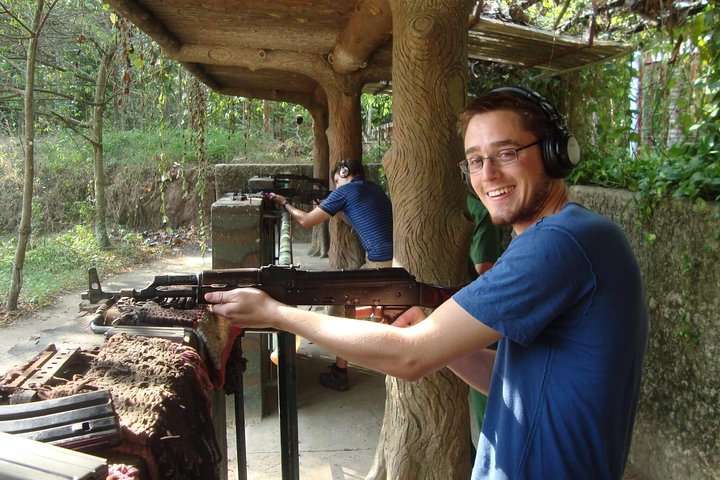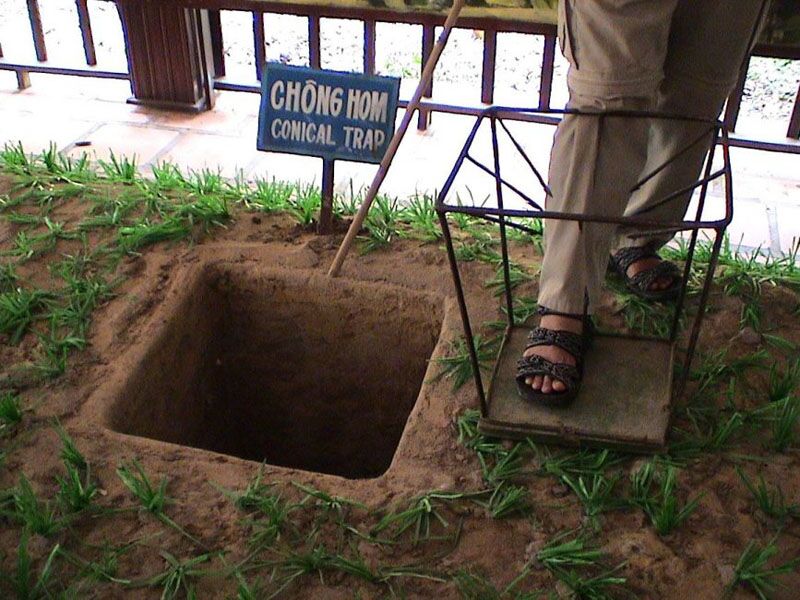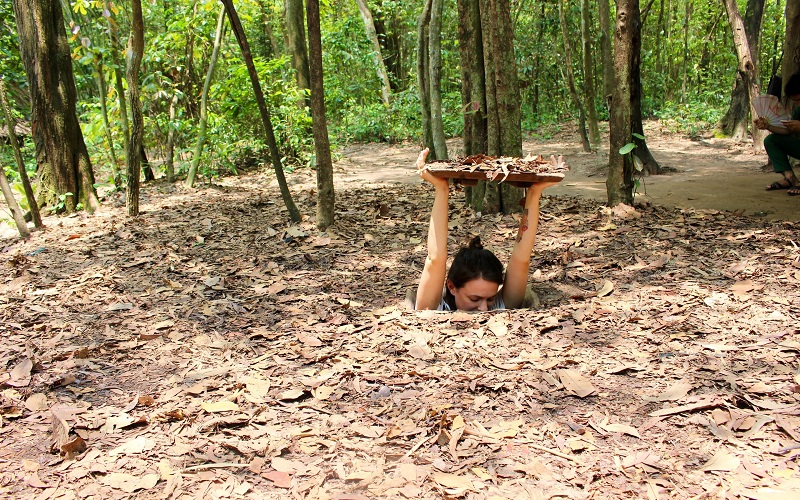Table of Contents
How were the cu chi tunnels built? Deep beneath the thick jungle canopies of Cu Chi, Vietnam, lies a remarkable feat of engineering and resilience – the Cu Chi Tunnels. This extensive network of underground tunnels, stretching for over 250 kilometers, played a pivotal role in the Vietnam War, serving as a sanctuary and stronghold for the Vietnamese guerillas against the formidable American forces. The construction of these tunnels was a testament to the ingenuity and determination of the Vietnamese people, who used simple tools and techniques to create an intricate underground system that proved to be a major thorn in the side of their enemies.
History of the Cu Chi Tunnels
The origins of the Cu Chi Tunnels can be traced back to the early 1940s when the Viet Minh, a nationalist movement fighting against French colonial rule, began constructing a series of rudimentary tunnels as a means of concealment and protection from enemy attacks. These initial tunnels were mainly used for storing weapons and supplies, as well as providing shelter during air raids. However, as the war intensified, the tunnels were expanded and refined, becoming an intricate underground network that spanned the entire Cu Chi district.
Expansion of the Tunnels during the Vietnam War
During the Vietnam War, How were the cu chi tunnels built, were continuously expanded and improved upon by the Viet Cong, the communist guerrilla force fighting against the South Vietnamese government and its allies. The tunnels were not only used for hiding and storing supplies, but also served as a base for launching surprise attacks on the enemy. They were also used to transport troops and supplies between different areas without being detected by the American forces.
The construction of the tunnels was a massive undertaking, with thousands of soldiers and civilians working tirelessly to expand and maintain them. It is estimated that at the peak of the war, there were around 16,000 people living and working in the tunnels.
Construction Techniques Used in the Cu Chi Tunnels

The construction of the Cu Chi Tunnels was a remarkable feat, considering the limited resources and tools available to the Vietnamese people. They used simple tools such as shovels, pickaxes, and baskets to dig out the tunnels, which were typically narrow and deep with a diameter of just 60 to 80 centimeters. This made it difficult for larger enemies to maneuver and also provided protection against bombs and grenades.
Reinforcement and Ventilation Systems
To ensure structural integrity, the tunnels were reinforced with bamboo poles, wooden planks, and even discarded oil drums. These materials were used to support the walls and ceilings of the tunnels, preventing them from collapsing. The ventilation system was also crucial in maintaining air circulation and preventing suffocation inside the tunnels. Small vents were strategically placed throughout the tunnels, allowing fresh air to enter while keeping the enemy’s scent out.
Innovative Use of Natural Resources
One of the most impressive aspects of the construction of the Cu Chi Tunnels was the innovative use of natural resources. The Vietnamese people utilized the abundance of bamboo and termite mounds found in the area to their advantage. Bamboo was used not only for reinforcement but also for creating trapdoors and camouflage. Termite mounds were used to create air vents and chimneys, providing a natural ventilation system for the tunnels.
Purpose and Significance of the Cu Chi Tunnels

How were the cu chi tunnels built served multiple purposes during the Vietnam War, making them a vital asset for the Viet Cong. They were primarily used as a hiding place and base for launching surprise attacks on the enemy. The tunnels also played a crucial role in transporting supplies and troops between different areas without being detected. They were also used as a communication network, allowing the Viet Cong to relay information and coordinate their movements.
Impact on the Vietnam War
The Cu Chi Tunnels were a major thorn in the side of the American forces, who struggled to combat the guerrilla tactics used by the Viet Cong. The tunnels provided a safe haven for the Vietnamese fighters, allowing them to regroup and plan their next move. They also served as a psychological weapon, instilling fear and uncertainty in the minds of the enemy.
The tunnels also played a significant role in the Tet Offensive, a massive surprise attack launched by the Viet Cong in 1968. The element of surprise, coupled with the strategic use of the tunnels, caught the American forces off guard and resulted in a major victory for the Vietnamese.
Innovations in Tunnel Building during the Vietnam War

The construction of the Cu Chi Tunnels was not only an impressive feat of engineering but also showcased the innovative techniques used by the Vietnamese people. These innovations were crucial in creating an extensive underground network that proved to be a formidable obstacle for the American forces.
Use of Booby Traps and Camouflage
The Vietnamese fighters were masters at using booby traps and camouflage to protect their tunnels. These traps were designed to maim or kill any unsuspecting enemy soldiers who stumbled upon them. They were also used to slow down the enemy’s progress and give the Viet Cong time to launch counterattacks.
Camouflage was also a vital aspect of the tunnel system. The entrances were carefully hidden under bushes or disguised as termite mounds, making it difficult for the enemy to locate them. This allowed the Vietnamese fighters to move freely in and out of the tunnels without being detected.
Creation of Multiple Layers and Entrances
To further confuse and disorient the enemy, the Vietnamese fighters created multiple layers of tunnels with various entrances and exits. This made it challenging for the American forces to determine the exact location of the tunnels and launch successful attacks.
Strategic Importance of the Cu Chi Tunnels

The Cu Chi Tunnels were strategically located near the Ho Chi Minh Trail, a crucial supply route for the North Vietnamese. This made them an essential asset for the Viet Cong, who used the tunnels to disrupt and sabotage the enemy’s supply lines. The tunnels also provided a safe passage for the North Vietnamese soldiers to enter South Vietnam undetected.
Comparison to Other Underground Systems
The Cu Chi Tunnels were not the only underground system used during the Vietnam War. The Viet Cong also utilized other tunnel networks, such as the Vinh Moc Tunnels in the north and the Iron Triangle Tunnels in the south. However, the Cu Chi Tunnels were by far the most extensive and well-developed, covering a vast area and serving multiple purposes.
Life Inside the Cu Chi Tunnels

Life inside the Cu Chi Tunnels was incredibly challenging, with cramped living conditions, constant fear of attacks, and limited resources. The tunnels were divided into different sections, including living quarters, storage areas, and even hospitals. The living quarters were small and dark, with barely enough room for a person to lie down. The lack of proper sanitation and ventilation also made it a breeding ground for diseases.
Despite these challenges, the Vietnamese fighters managed to survive and even thrive in the tunnels. They developed a strong sense of camaraderie and relied on each other for support and protection. The tunnels also served as a symbol of resilience and determination for the Vietnamese people, who refused to give up their fight for independence.
Challenges Faced in Building the Cu Chi Tunnels

The construction of the Cu Chi Tunnels was not without its challenges. The Vietnamese people faced numerous obstacles and risks while building and maintaining the tunnels.
Constant Threat of Bombing and Flooding
One of the biggest challenges faced by the Vietnamese fighters was the constant threat of bombing and flooding. The American forces used powerful bombs and chemicals, such as Agent Orange, to destroy the tunnels. This not only caused physical damage but also posed a significant health risk to those living inside the tunnels.
The rainy season also presented a significant challenge, as heavy rainfall could flood the tunnels and make them uninhabitable. The Vietnamese people had to constantly work to repair and reinforce the tunnels to prevent collapse or flooding.
Lack of Resources and Supplies
The construction of the Cu Chi Tunnels was primarily done using simple tools and materials found in the surrounding area. This meant that resources were limited, and the Vietnamese fighters had to be resourceful and creative in their approach. They often had to recycle and repurpose materials to build and maintain the tunnels, making it a challenging and time-consuming process.
Legacy of the Cu Chi Tunnels in Modern Times

Today, the Cu Chi Tunnels serve as a popular tourist attraction, offering visitors a glimpse into the harsh realities of war and the resilience of the Vietnamese people. The tunnels have been preserved and restored, with some sections open for tourists to explore. Visitors can crawl through the narrow tunnels, see the booby traps and camouflaged entrances, and learn about the daily life of the Vietnamese fighters during the war.
Impact on Modern Tunnel Building Techniques
The construction of the Cu Chi Tunnels has also had a significant impact on modern tunnel building techniques. The innovative use of natural resources and the strategic placement of multiple layers and entrances have influenced the design and construction of underground systems around the world.
Conclusion
How were the cu chi tunnels built are a testament to the determination and resilience of the Vietnamese people, who used their ingenuity and resourcefulness to create an extensive underground network that played a crucial role in the Vietnam War. The tunnels served as a sanctuary and stronghold for the Viet Cong, allowing them to launch surprise attacks and disrupt the enemy’s supply lines. Today, the Cu Chi Tunnels stand as a symbol of the enduring spirit of the Vietnamese people and their unwavering fight for independence.